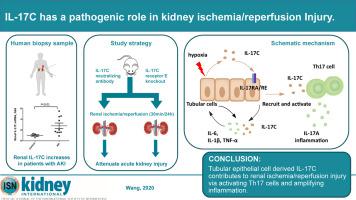当前位置:
X-MOL 学术
›
Kidney Int.
›
论文详情
Our official English website, www.x-mol.net, welcomes your
feedback! (Note: you will need to create a separate account there.)
IL-17C has a pathogenic role in kidney ischemia/reperfusion injury.
Kidney International ( IF 14.8 ) Pub Date : 2020-02-04 , DOI: 10.1016/j.kint.2020.01.015 Feng Wang 1 , Jianyong Yin 2 , Yingying Lin 2 , Fangfei Zhang 2 , Xuanchen Liu 3 , Guangyuan Zhang 4 , Yiwei Kong 5 , Zeyuan Lu 2 , Rui Wu 2 , Niansong Wang 2 , Tao Xing 6 , Youcun Qian 7
Kidney International ( IF 14.8 ) Pub Date : 2020-02-04 , DOI: 10.1016/j.kint.2020.01.015 Feng Wang 1 , Jianyong Yin 2 , Yingying Lin 2 , Fangfei Zhang 2 , Xuanchen Liu 3 , Guangyuan Zhang 4 , Yiwei Kong 5 , Zeyuan Lu 2 , Rui Wu 2 , Niansong Wang 2 , Tao Xing 6 , Youcun Qian 7
Affiliation

|
Cytokines are necessary to trigger the inflammatory response in kidney ischemia/reperfusion injury. Interleukin-17C (IL-17C), a unique member of the IL-17 family, is a cytokine produced by epithelial cells implicated in host defense and autoimmune diseases. However, little is known about the role of IL-17C in acute kidney injury. We investigated this and found that IL-17C was significantly increased in kidney biopsies of patients and mice with acute kidney injury. Exposure to hypoxia induced upregulation of IL-17C in kidney tubular epithelial cells. To further investigate the role of IL-17C, kidney ischemia/reperfusion injury was induced in mice. Inhibition of IL-17C action with a neutralizing antibody or IL-17 receptor E (IL-17RE) knockout attenuated tubular injury, kidney oxidative stress, and kidney inflammation. Mechanistically, both IL-17C neutralization and IL-17RE knockout attenuated TH17 activation and IL-17A expression in kidneys of mice with acute kidney injury. TNF-α and IL-1β, downstream cytokines of IL-17C, were also reduced in IL-17C antibody pretreated and IL-17RE knockout mice. Additionally, IL-17C knockdown with siRNA decreased hypoxia-induced inflammation in kidney tubular cells and silencing IL-17RE abrogated the effects of IL-17C in kidney tubular cells. Thus, IL-17C may participate in the inflammatory response of acute kidney injury and inhibition of IL-17C or blockade of IL-17 RE may be a novel therapeutic strategy for the treatment of acute kidney injury.
中文翻译:

IL-17C 在肾脏缺血/再灌注损伤中具有致病作用。
细胞因子是触发肾脏缺血/再灌注损伤中的炎症反应所必需的。白细胞介素 17C (IL-17C) 是 IL-17 家族的独特成员,是一种由上皮细胞产生的细胞因子,与宿主防御和自身免疫疾病有关。然而,关于 IL-17C 在急性肾损伤中的作用知之甚少。我们对此进行了调查,发现急性肾损伤患者和小鼠的肾活检中 IL-17C 显着增加。暴露于缺氧诱导肾小管上皮细胞中 IL-17C 的上调。为了进一步研究 IL-17C 的作用,在小鼠中诱导了肾缺血/再灌注损伤。用中和抗体或 IL-17 受体 E (IL-17RE) 敲除抑制 IL-17C 作用可减轻肾小管损伤、肾脏氧化应激和肾脏炎症。机械地,IL-17C 中和和 IL-17RE 敲除均减弱了急性肾损伤小鼠肾脏中 TH17 的活化和 IL-17A 的表达。在 IL-17C 抗体预处理和 IL-17RE 敲除小鼠中,IL-17C 的下游细胞因子 TNF-α 和 IL-1β 也减少了。此外,用 siRNA 敲低 IL-17C 可减少缺氧诱导的肾小管细胞炎症,沉默 IL-17RE 可消除 IL-17C 在肾小管细胞中的作用。因此,IL-17C可能参与急性肾损伤的炎症反应,抑制IL-17C或阻断IL-17 RE可能是治疗急性肾损伤的一种新的治疗策略。在 IL-17C 抗体预处理和 IL-17RE 敲除小鼠中也减少。此外,用 siRNA 敲低 IL-17C 可减少缺氧诱导的肾小管细胞炎症,沉默 IL-17RE 可消除 IL-17C 在肾小管细胞中的作用。因此,IL-17C可能参与急性肾损伤的炎症反应,抑制IL-17C或阻断IL-17 RE可能是治疗急性肾损伤的一种新的治疗策略。在 IL-17C 抗体预处理和 IL-17RE 敲除小鼠中也减少。此外,用 siRNA 敲低 IL-17C 可减少缺氧诱导的肾小管细胞炎症,沉默 IL-17RE 可消除 IL-17C 在肾小管细胞中的作用。因此,IL-17C可能参与急性肾损伤的炎症反应,抑制IL-17C或阻断IL-17 RE可能是治疗急性肾损伤的一种新的治疗策略。
更新日期:2020-02-04
中文翻译:

IL-17C 在肾脏缺血/再灌注损伤中具有致病作用。
细胞因子是触发肾脏缺血/再灌注损伤中的炎症反应所必需的。白细胞介素 17C (IL-17C) 是 IL-17 家族的独特成员,是一种由上皮细胞产生的细胞因子,与宿主防御和自身免疫疾病有关。然而,关于 IL-17C 在急性肾损伤中的作用知之甚少。我们对此进行了调查,发现急性肾损伤患者和小鼠的肾活检中 IL-17C 显着增加。暴露于缺氧诱导肾小管上皮细胞中 IL-17C 的上调。为了进一步研究 IL-17C 的作用,在小鼠中诱导了肾缺血/再灌注损伤。用中和抗体或 IL-17 受体 E (IL-17RE) 敲除抑制 IL-17C 作用可减轻肾小管损伤、肾脏氧化应激和肾脏炎症。机械地,IL-17C 中和和 IL-17RE 敲除均减弱了急性肾损伤小鼠肾脏中 TH17 的活化和 IL-17A 的表达。在 IL-17C 抗体预处理和 IL-17RE 敲除小鼠中,IL-17C 的下游细胞因子 TNF-α 和 IL-1β 也减少了。此外,用 siRNA 敲低 IL-17C 可减少缺氧诱导的肾小管细胞炎症,沉默 IL-17RE 可消除 IL-17C 在肾小管细胞中的作用。因此,IL-17C可能参与急性肾损伤的炎症反应,抑制IL-17C或阻断IL-17 RE可能是治疗急性肾损伤的一种新的治疗策略。在 IL-17C 抗体预处理和 IL-17RE 敲除小鼠中也减少。此外,用 siRNA 敲低 IL-17C 可减少缺氧诱导的肾小管细胞炎症,沉默 IL-17RE 可消除 IL-17C 在肾小管细胞中的作用。因此,IL-17C可能参与急性肾损伤的炎症反应,抑制IL-17C或阻断IL-17 RE可能是治疗急性肾损伤的一种新的治疗策略。在 IL-17C 抗体预处理和 IL-17RE 敲除小鼠中也减少。此外,用 siRNA 敲低 IL-17C 可减少缺氧诱导的肾小管细胞炎症,沉默 IL-17RE 可消除 IL-17C 在肾小管细胞中的作用。因此,IL-17C可能参与急性肾损伤的炎症反应,抑制IL-17C或阻断IL-17 RE可能是治疗急性肾损伤的一种新的治疗策略。









































 京公网安备 11010802027423号
京公网安备 11010802027423号